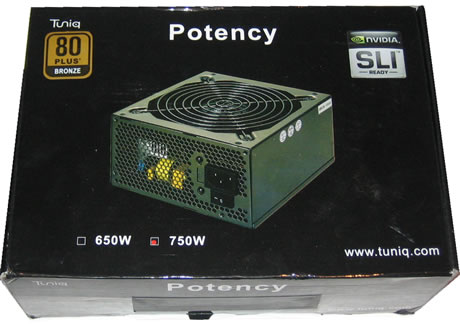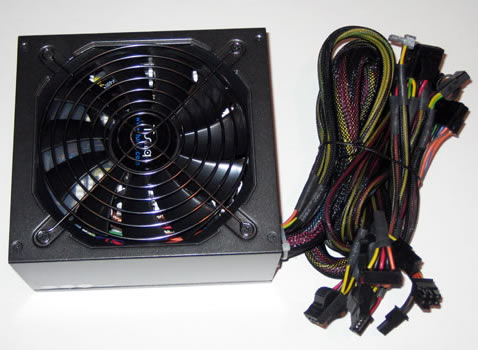1. Features
Tuniq, a division of Sunbeamtech, recently released its first Power Suppy Unit (PSU) for gamers and entry level users. The Tuniq Potency 750Watt power supply has a certified high efficiency 80 plus, with an efficiency of over 85.30% at multi-output. The supported Active PFC technology reduces energy consumption while at the same time, the PSU is producing a less heat and has less cooling requirements.

- Features
- Power Output: 750 watts
- Certified 80+ Bronze Efficiency
- Dimensions: 160 x 150 x 86mm
- Bottom mounted 140mm cooling fan
- Active PFC
- All cables sleeved
- EZ-Grip connectors
- Advanced Off-Line Cooling Feature (Fan will not stop working until the temp below 50C)
- Over/Under Voltage Protection
- Over Current Protection
- Short Circuit Protection
- Over Load Protection
- NVidia SLI Certified
- Offered in 750w and 650w sizes
- 3-year Warranty
2. Opening the box
TheTuniq Potency 750W retails for around $120 (including VAT), which is reasonable for the PSU in the 750Watt category.
Below you can see the retail box. Besides the obvious infrmation on it, there are two big logos: The 80Plus Bronze award, and the Nvidia SLI certification, which however is not listed at the official Nvidia website... According to the PSU's specs, you should not have any problems ysing it to power a dual VGA configuration but for a 3ple graphics cards setup you should go for something more powerful.

The Tuniq Potency 750Watt has all the cables attached to the main unit and it comes with a massive 140mm rotating fan. Tuniq has added a special feature that keeps the fan operating until a built-in detector show that the temperature inside your PC box is lower than 50degrees Celsius. This means that no matter if you have alerady powered down you PC, the PSU fan will be probably rotating for some additional minutes.

In the box you will also find a printed user manual, a power cord, several mounting screws, some zip ties and a Molex extension/splitter cable in case you need it.
The main unit is compact enough following the typical dimensions of the category. This means that you will be able to esily install it in any type of PC case except from small desktop or very basic tower designs.
 .
.
The power supply has a matte black finish like the majority of the power supplies we have recently have tested in our labs. All the edges are not sharp making handling easy and safe.
The rear side of the device has a honeycomb design that keeps the PSU's internal temperature as low as possibe. The PSU's specs and ratings are also available on the sticker found on the side of the unit:


The power supply has four +12V rails with 0-18Amps output summing a total Wattage of 650W. The +5V boosts an impressive 30A, while the +3.3V rail offers 28A. Finally, the +5VSB contributes to the overall nominal Wattage by some additional 15W.
The Tuniq Potency offers a 20+4 and 4+4ATX pin power connectors, meaning that the these connectors are not bonded together. While this may be handy for older motherboards, 24-pin and 8-pin connectors would be more convenient.
Below you can see all the available power cables.
| Connectors Included |
# |

ATX 24 pin & 20 pin compatible |
x1 |

EPS/ATX12V 4+4 pin |
x1 |

PCI-E 6 pin |
x2 |

PCI-E 6+2 pin |
x2 |

SATA |
x6 |

4 pin Peripheral |
x6 |

Floppy |
x1 |

The number of the available power connectors is typical for this category of PSUs. You will find 6 molex and 6 sata cables. The PCI-e 6pin and the 6+2 pin connectors are very useful if you are having a new graphics card. The cables are also long enough to cover the needs of a midi case.
3. Basic tests
Testing the efficiency of a PSU is not very easy and it requires use of specialized hardware. The goal would be to see whether the PSU delivers efficient current to simultaneously power all the devices that are connected to the PSUs power lines.
For this review, we have just tried to load our test PC with many devices and created extensive CPU+3D workload by using 3D Mark Vantage and PC Mark Vantage. Our test PC was as follows:
- Motherboard: Asus P6T Deluxe/OC Palm Edition
- CPU: Intel Core i7-920 retail
- 2x Asus EN9800GTX
- 3x1GB Crucial PC3-10600
- 1xWD 80JB SATA I
- 1xSeagate 80GB SATAII
- Windows VISTA 32bit SP1
All PSU ratings were monitored with Everest Ultimate Edition v3.0. The following table lists the industry wide specifications for DC Output Voltage.

While we were running both benchmarks, we were monitoring the voltage of the basic power outputs of teh PSU, in an effort to see how much stress the PSU had taken. A summary of the results are available below:
|
Minimum |
Maximum |
+3.3 V |
V |
3,23 |
3,26 |
+5 V |
V |
4,88 |
4,93 |
+12 V |
V |
12,20 |
12,27 |
The results are adequate and they stay within the standard range. The dual VGA setup seems to strech the power supply a little bit resulting to a slight (0.07V) variation of the voltage of the +12V rail.
4. Final thoughts
 While we had the chance to use the new Tuniq Potency 750Watt power supply for many hours, we did not actually measured the performance and reliability of it using standard equipment. As a result, consider this brief article as a report of our impressions from Tuniq' new PSU, from the end-user's aspect.
While we had the chance to use the new Tuniq Potency 750Watt power supply for many hours, we did not actually measured the performance and reliability of it using standard equipment. As a result, consider this brief article as a report of our impressions from Tuniq' new PSU, from the end-user's aspect.
The PSU has enough power to make your PC run smoothly in your daily gaming tasks. Our simple tests showed that the device offers efficient power even for SLI dual-GPU configurations, while its overall structure looks solid and possibly better than what we would initially expect for a 750W PSU that costs just $120.
Of course, we would prefer to see more power outputs as well as a modular design for this PSU, although these could make its retail price higher.

And if all these are not convincing enough, the 3-year warranty of this device is available to cover any possible issues you may face while using it.
- The Good
- 750Watt output
- 80Plus.org Bronze rating
- Good build-quality
- Active PFC design
- ATX v2.2 certified
- Enough connectors with good length
- 3 years of warranty
- Proper retail price for this category
- Low variation at +12V rail under SLI configurations
- Fan keeps working to lower the temperature even after the system is powered off
- The Bad
- Modular cable design
- SLI certification not available at Nvidia's official web site